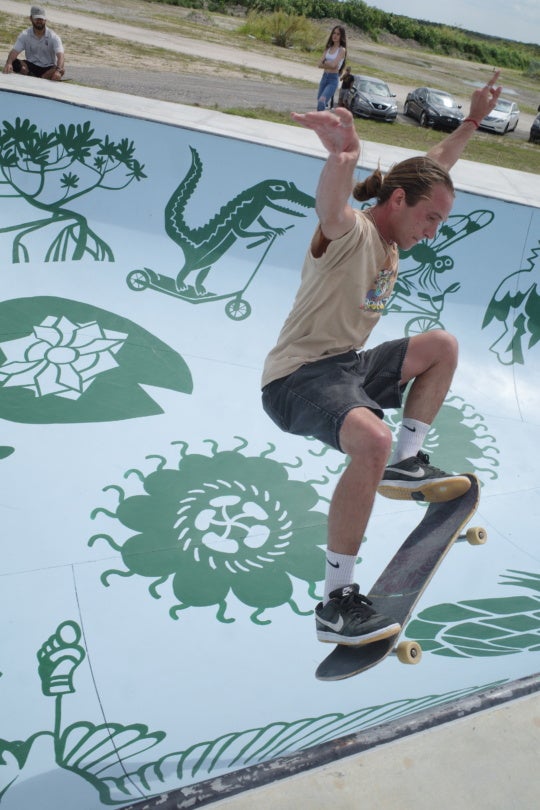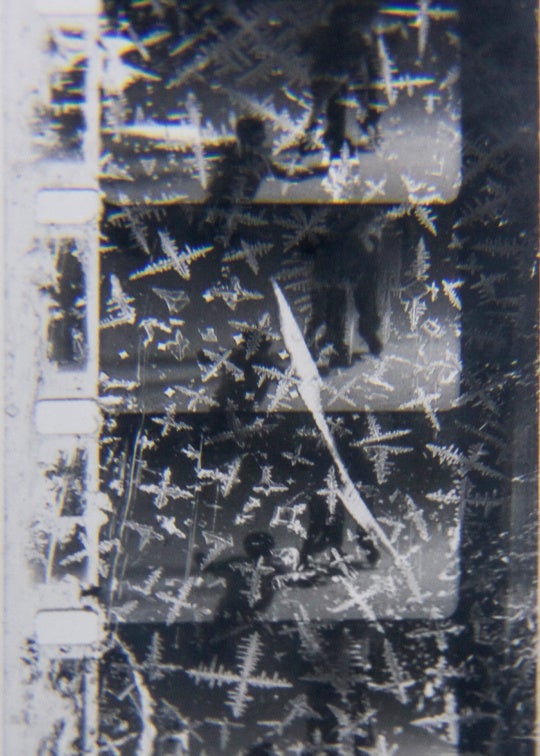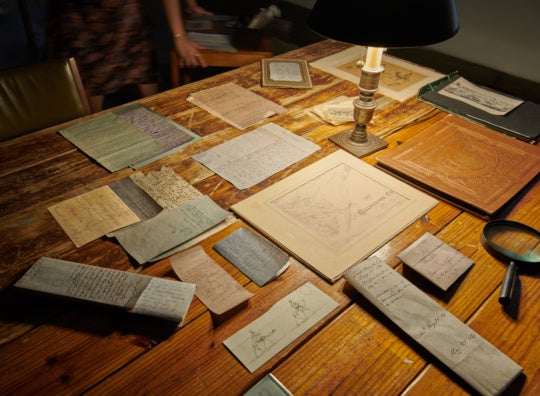
Critic Lilly Lampe met with artist Chris Chambers in his studio at [Atlanta’s] Metropolitan Warehouses to discuss his video work and installation for the 2013 Hudgens Prize.
(Author’s note: this interview took place before the current exhibition opened.)
Chris Chambers: My studio practice has shifted a lot. I haven’t used this space for a little while, other than showing off old stuff.
Lilly Lampe: How long have you been in this studio?
CC: Almost four years.
LL: What do you mean by your studio practice has shifted?
CC: My practice shifts between projects. In this space, I do collage and drawing work [gesturing towards drafting table]. It’s not entirely conscious but I tend to focus on one type of medium [at a time] and then shift to a completely new medium. Right now I have three basic things that I cycle through: these pen and ink drawings, collages, and more general video work.
I have another space up there [gestures towards a lofted platform] with a VCR and a TV.

LL: What is your artistic background that led you towards these current practices?
CC: I went to Savannah [SCAD] and studied painting… well, I went in for film and video and then it became clear that I’m not particularly good at the large scale of video direction and managing different people… I’m much better at focusing on one thing. So I shifted to illustration and then painting. Skipping around, I saw that it wasn’t so much about what [my professors] were teaching me in terms of technique, but the thought-process and how [to] approach the subject. I became more drawn to the thought process of painting.
LL: What specifically attracted you?
CC: A lot of it was subconscious and intuitive. With illustration, for example, you always have the idea of a client and how the work encapsulates their idea. I had a lot of teachers that emphasized the difference between illustration and, say, fine art or painting or whatever, namely the reproductive aspects of illustration. Which is not really true I think… most illustration is a literal process of translating an idea.
LL: Let’s talk about your recent work. Looking around your studio, there’s a large amount of dated imagery and dated technology. We’ve got a stack of VHS’s with three different copies of Field of Dreams and a ton of old picture frames. Is there a specific time period you’re looking at [for] a particular aesthetic?
CC: Most of the source material I use tends to be from the 70s, 80s, and early 90s. These were my formative years and were particularly media-saturated years, with the rise of home entertainment and cable television, and my upbringing was very media-centric. I draw all my video work from found-VHS’s. VHS occupies a very specific time period, from its beginning to end. They don’t make VHS tapes anymore, and people [as] a whole don’t watch them anymore. It’s kind of a dead medium and I’m not sure if I’m drawn to it because it’s dead, or I’m drawn to it and it also happens to be dead. I’ve been doing yearbook portraits off and on for a few years; the last time I did, I realized yearbooks don’t mean anything anymore. I don’t do interviews with kids in school or anything, but the importance of the yearbook as a compendium of people you used to know and pulling it out years later and looking through it…that experience doesn’t matter anymore because these days you’ve got an internet yearbook with social media like Facebook.
I’m also drawn to the catalog aspect of it. It’s a compilation of hundreds of faces and everyone looks kind of strange.

LL: Are you pulling from your yearbooks or found yearbooks?
CC: I have a couple of my yearbooks in there but I mostly pull from found yearbooks.
LL: Where are you finding your yearbooks and VHS tapes?
CC: It’s a mix. Some are from thrift stores, others from Ebay, and people will just give them to me because they know I’m interested.
LL: Is that becoming a problem? Are people unloading on you instead of taking their junk to the Salvation Army?
CC: [laughs] It’s not a severe problem yet. But I have things that people have given me just sitting around because I haven’t found a place for them yet. But I haven’t found a place for a lot of stuff. This [gestures at his shelves] is probably the most organized I have anything anywhere.
LL: It sounds like organization is very important to you in your studio. Like there’s that puppet under the stairs your friend [artist Patrick Coll] left that you mentioned taking up space and getting dusty, but it’s tucked away and not really in the middle of anything…
CC: Yeah but that’s space where I could put other stuff and while it’s there I can’t take stuff from over here and put it in there… I spend a lot of time trying to figure out where to put everything. I feel like a lot of my work ends up being about media and consuming media and consuming things. To make my work I have to amass all this stuff and I don’t spend a lot of money on it, but I do spend a lot of time finding it and organizing it. I’ve become part of this process that I don’t particularly like and I don’t do it, I think, for the same reasons that people sort of consume…or maybe I do! Because I do like these materials, but I’ve only watched a fraction of the materials I’ve collected. I mainly watch them for projects. It’s rare that I get to watch them for enjoyment.
The project for the Hudgens is all [sourced from] Kevin Costner’s films that were on VHS.

LL: Oh I’m so excited! I loved Waterworld when it came out. Wow, some of these are awful!
CC: Yeah, there are four or five good films. Most range from bad to awful. Robin Hood was really bad, Bull Durham was really good, and The Untouchables is kind of amazing. It’s a Brian De Palma film about Al Capone. Robert De Niro plays Capone and Sean Connery’s in it. It’s not as good as it could have been but it’s still pretty good. There’s this one scene that’s like a ten-minute slow-motion scene. I’d seen parodies of it and then I watched the VHS and got tingles from watching it, it was so high in intensity! It was this shootout at a train station and it’s one of my favorite film scenes ever.
LL: Do you know The Clock by Christian Marclay that was at MoMA?
CC: I drove up to New York specifically to see that.
LL: Did you like it?
CC: Yeah, I sat through it for five hours. We wanted do 24 hours but it was only open for the full cycle during the weekend.
But back to the Costner project—I’m still cataloging all the scenes. I’m going to approach it by finding these like scenes since he does a lot of the same thing. When he became a star in the late 80s, all of his movies had these close-ups and he rides horses in all his movies—even his first one, which is like a soft-core porn. He plays baseball in three films but is a baseball player in four. This one’s [The Upside of Anger] pretty good; it’s the last one that was released on VHS. He plays an ex-MVP. Even in the films he plays “loser” characters, he is always sort of the best at something—generally something hyper-masculine.
LL: How many VHS-based works have you done?
CC: Maybe seven or eight installations. I’ve done a couple of found-VHS music videos also. A number of them have been exhibited in public settings. I did one for each of the first two Le Flash’s, which were the precursors for the Flux shows. I did one in Eyedrum’s old space and one for the first Elevate, which went on for five weeks. I would take videos [that] people would give me during the exhibition, and update [the work] every week and a half or two weeks.
LL: What sort of clips were you using and what was the duration?
CC: I started with a couple of videos someone gave me. They were of some sort of beading-hair system from the early 90’s, an instructional video of how to assemble some brand of drums, then a brief drumming lesson by guy who replaced the first drummer in Kiss, and a television recording of Oprah’s interview with Michael Jackson. After that it was completely random; at one point a couple in Brookhaven gave me 4 or 5 paper grocery bags full of things taped off of the television in the early 90’s. That was all gold.
LL: How do you work with VHS?
CC: I’ve got this handy VCR-TV all-in-one combination. I have forty TVs but only one other VCR-TV combo. I have a truck in storage that’s full of them. It’s easier to haul them that way.
LL: Like a spy-kit full of video and audio equipment?
CC: That’s ideally what it would be, but it’s packed. There’s no way to get into the back without removing all of the televisions.
LL: So you screen stuff on the VCR-TV combo and then what?
CC: I hook it up to my mini-DV Elura and I record the smaller clips so I don’t have to digitize the entire VHS. I go through those visually and then I input that into the computer and then I edit it on nonlinear video editing software, specifically Final Cut Pro. For the Hudgens, half of these videos have copyright protection so I had to get around them with this weird little box I found on ebay that only performs this one function.
It feels like an interpretive process. [I’m] interfacing with old media and bringing it through a computer and back to translate the material. Then I splice the scenes and try to organize and catalogue them.
LL: In your videos are you trying to create a narrative or break away from the pre-set narrative of the films?
CC: Hopefully both. They end up being pretty non-linear. It’s easier to show it. To display my installations after the fact I basically make these composites. Each one represents a TV and they’re stacked. For Elevate, I had forty or so TVs running. All my video pieces are multi-channel so there are multiple sounds and videos going on at once. I edit with an eye to the audio first, so there’s a sound composition.
LL: You seem to gravitate towards recognizable cultural figures.
CC: Well, that’s more so with the Michael Jackson piece because I used VHS [footage] people would give me so I didn’t have much control over what I got. In the ones before this, it was less important that the clips be recognizable outright. For Michael in particular, I got feature films and stuff taped off of primetime TV so there is more recognizable [footage]. For the Kevin Costner piece, [he’s] kind of unavoidably pop culture, though, there was someone over here last week who didn’t know who Kevin Costner was. But overall, the aesthetic of it is very familiar—but it’s not important that the viewer have seen these movies before.

LL: In your video work, there are a lot of linear lines, seen in rippling screen static, perspectival lines, and the lines of hair. Your drawings also have a lot of strong linear patterns.
CC: Definitely in the drawings. I haven’t thought about the patterns in the video but it definitely sticks out. In a lot of my videos, there are logos and symbols and strong graphic images and I’m really drawn to that. Some of my pieces have a lot of hair and motion. I used a shampoo commercial in one so there was wet hair, dry hair, full hair, and hair moving and whipping. My collages are literally constructed out of many linear lines.
I wouldn’t use an image that wasn’t interesting in some way. The overall composition is very important and one aspect can be deficient if another aspect is stronger.
LL: What sort of aesthetic are you going for?
CC: It differs from source to source. I got into using these sources initially because they’re really fun to see. This content—the videos and commercials—took so much money and effort to make. You look at it now and its fun because, well, I don’t think many people sit around watching these things for fun, but to me it’s fascinating because of all that effort and the fact that it looks so stupid or ridiculous. Each one is using whatever fashions or ideas of the day to create whatever is being portrayed and there’s like an archaeological aspect, archaeology of old media. I like objects and artifacts that speak something about the time in which they were created; it’s never really about how that time and place really was, but more about how the people making these objects aspired to be, in a way. The Kevin Costner thing has been kind of surprising because my original concept was a lot simpler, just taking his major films which were the only ones I knew at the time, and doing something with that. And now…it’s expanded.
House rules for commenting:
1. Please use a full first name. We do not support hiding behind anonymity.
2. All comments on BURNAWAY are moderated. Please be patient—we’ll do our best to keep up, but sometimes it may take us a bit to get to all of them.
3. BURNAWAY reserves the right to refuse or reject comments.
4. We support critically engaged arguments (both positive and negative), but please don’t be a jerk, ok? Comments should never be personally offensive in nature.




